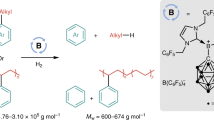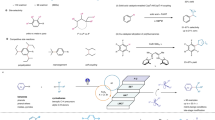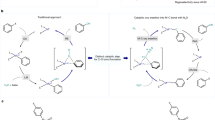Abstract
The activation of abundant molecules such as hydrocarbons and atmospheric nitrogen (N2) remains a challenge because these molecules are often inert. The formation of carbon–nitrogen bonds from N2 typically has required reactive organic precursors that are incompatible with the reducing conditions that promote N2 reactivity1, which has prevented catalysis. Here we report a diketiminate-supported iron system that sequentially activates benzene and N2 to form aniline derivatives. The key to this coupling reaction is the partial silylation of a reduced iron–dinitrogen complex, followed by migration of a benzene-derived aryl group to the nitrogen. Further reduction releases N2-derived aniline, and the resulting iron species can re-enter the cyclic pathway. Specifically, we show that an easily prepared diketiminate iron bromide complex2 mediates the one-pot conversion of several petroleum-derived arenes into the corresponding silylated aniline derivatives, by using a mixture of sodium powder, crown ether, trimethylsilyl bromide and N2 as the nitrogen source. Numerous compounds along the cyclic pathway are isolated and crystallographically characterized, and their reactivity supports a mechanism for sequential hydrocarbon activation and N2 functionalization. This strategy couples nitrogen atoms from N2 with abundant hydrocarbons, and maps a route towards future catalytic systems.
This is a preview of subscription content, access via your institution
Access options
Access Nature and 54 other Nature Portfolio journals
Get Nature+, our best-value online-access subscription
$29.99 / 30 days
cancel any time
Subscribe to this journal
Receive 51 print issues and online access
$199.00 per year
only $3.90 per issue
Buy this article
- Purchase on Springer Link
- Instant access to full article PDF
Prices may be subject to local taxes which are calculated during checkout





Similar content being viewed by others
Data availability
Materials and methods, experimental procedures, useful information, spectra and mass spectrometry data are available in Supplementary Information. Raw data are available from the corresponding author on reasonable request. The crystallographic datasets generated during the current study are publicly available from the Cambridge Crystallographic Data Centre (CCDC) repository at https://www.ccdc.cam.ac.uk/structures/ with CCDC numbers 1937999, 1978000, 1938001, 1938002, 1939265, 1939266 and 1966313.
Change history
18 September 2020
A Correction to this paper has been published: https://doi.org/10.1038/s41586-020-2722-x
References
Kim, S., Loose, F. & Chirik, P. J. Beyond ammonia: nitrogen-element bond forming reactions with coordinated dinitrogen. Chem. Rev. 120, 5637–5681 (2020).
McWilliams, S. F. et al. Effects of N2 binding mode on iron-based functionalization of dinitrogen to form an iron(iii) hydrazido complex. J. Am. Chem. Soc. 140, 8586–8598 (2018).
Schlögl, R. in Handbook of Heterogeneous Catalysis Vol. 5 2501–2575 (Wiley, 2008).
Burgess, B. K. & Lowe, D. J. Mechanism of molybdenum nitrogenase. Chem. Rev. 96, 2983–3012 (1996).
Hoffman, B. M., Lukoyanov, D., Yang, Z. Y., Dean, D. R. & Seefeldt, L. C. Mechanism of nitrogen fixation by nitrogenase: the next stage. Chem. Rev. 114, 4041–4062 (2014).
Schrock, R. R. Catalytic reduction of dinitrogen to ammonia at a single molybdenum center. Acc. Chem. Res. 38, 955–962 (2005).
Chalkley, M. J., Del Castillo, T. J., Matson, B. D., Roddy, J. P. & Peters, J. C. Catalytic N2-to-NH3 conversion by Fe at lower driving force: a proposed role for metallocene-mediated PCET. ACS Cent. Sci. 3, 217–223 (2017).
Nishibayashi, Y. Development of catalytic nitrogen fixation using transition metal-dinitrogen complexes under mild reaction conditions. Dalton Trans. 47, 11290–11297 (2018).
Chen, J. G. et al. Beyond fossil fuel–driven nitrogen transformations. Science 360, eaar6611 (2018).
Andino, J. G., Mazumder, S., Pal, K. & Caulton, K. G. New approaches to functionalizing metal-coordinated N2. Angew. Chem. Int. Ed. 52, 4726–4732 (2013).
Hidai, M. & Mizobe, Y. Recent advances in the chemistry of dinitrogen complexes. Chem. Rev. 95, 1115–1133 (1995).
MacKay, B. A. & Fryzuk, M. D. Dinitrogen coordination chemistry: on the biomimetic borderlands. Chem. Rev. 104, 385–402 (2004).
Mori, M. Activation of nitrogen for organic synthesis. J. Organomet. Chem. 689, 4210–4227 (2004).
Keane, A. J., Farrell, W. S., Yonke, B. L., Zavalij, P. Y. & Sita, L. R. Metal-mediated production of isocyanates, R3ENCO from dinitrogen, carbon dioxide, and R3ECl. Angew. Chem. Int. Ed. 54, 10220–10224 (2015).
Figueroa, J. S., Piro, N. A., Clough, C. R. & Cummins, C. C. A nitridoniobium(v) reagent that effects acid chloride to organic nitrile conversion: synthesis via heterodinuclear (Nb/Mo) dinitrogen cleavage, mechanistic insights, and recycling. J. Am. Chem. Soc. 128, 940–950 (2006).
Curley, J. J., Cozzolino, A. F. & Cummins, C. C. Nitrogen fixation to cyanide at a molybdenum center. Dalton Trans. 40, 2429–2432 (2011).
Klopsch, I., Kinauer, M., Finger, M., Würtele, C. & Schneider, S. Conversion of dinitrogen into acetonitrile under ambient conditions. Angew. Chem. Int. Ed. 55, 4786–4789 (2016).
Kakiuchi, F. & Chatani, N. Catalytic methods for C-H bond functionalization: application in organic synthesis. Adv. Synth. Catal. 345, 1077–1101 (2003).
Davies, H. M. L., Du Bois, J. & Yu, J.-Q. C–H functionalization in organic synthesis. Chem. Soc. Rev. 40, 1855–1856 (2011).
Smith, J. M. et al. Studies of low-coordinate iron dinitrogen complexes. J. Am. Chem. Soc. 128, 756–769 (2006).
Holland, P. L. Electronic structure and reactivity of three-coordinate iron complexes. Acc. Chem. Res. 41, 905–914 (2008).
Kalman, S. E. et al. Facile and regioselective C–H bond activation of aromatic substrates by an Fe(ii) complex involving a spin-forbidden pathway. Organometallics 32, 1797–1806 (2013).
Hickey, A. K., Lutz, S. A., Chen, C.-H. & Smith, J. M. Two-state reactivity in C–H activation by a four-coordinate iron(0) complex. Chem. Commun. 53, 1245–1248 (2017).
Yu, Y., Brennessel, W. W. & Holland, P. L. Borane B−C bond cleavage by a low-coordinate iron hydride complex and N−N bond cleavage by the hydridoborate product. Organometallics 26, 3217–3226 (2007).
Sellmann, D. & Weiss, W. First reaction of dinitrogen ligands with bases: reduction of coordinated dinitrogen by nucleophilic attack. Angew. Chem. 89, 918–919 (1977).
Sellmann, D. & Weiss, W. Consecutive nucleophilic and electrophilic attack on nitrogen ligands: synthesis of azomethane from molecular nitrogen. Angew. Chem. 90, 295–296 (1978).
Deegan, M. M. & Peters, J. C. Electrophile-promoted Fe-to-N2 hydride migration in highly reduced Fe(N2)(H) complexes. Chem. Sci. 9, 6264–6270 (2018).
Jacobs, B. P., Wolczanski, P. T., Jiang, Q., Cundari, T. R. & MacMillan, S. N. Rare examples of Fe(iv) alkyl-imide migratory insertions: impact of Fe–C covalency in (Me2IPr)Fe(=NAd)R2. J. Am. Chem. Soc. 139, 12145–12148 (2017).
Nishibayashi, Y. Recent progress in transition-metal-catalyzed reduction of molecular dinitrogen under ambient reaction conditions. Inorg. Chem. 54, 9234–9247 (2015).
Siedschlag, R. B. et al. Catalytic silylation of dinitrogen with a dicobalt complex. J. Am. Chem. Soc. 137, 4638–4641 (2015).
Piascik, A. D., Li, R., Wilkinson, H. J., Green, J. C. & Ashley, A. E. Fe-catalyzed conversion of N2 to N(SiMe3)3 via an Fe-hydrazido resting state. J. Am. Chem. Soc. 140, 10691–10694 (2018).
Tanabe, Y. & Nishibayashi, Y. Recent advances in catalytic silylation of dinitrogen using transition metal complexes. Coord. Chem. Rev. 389, 73–93 (2019).
Lee, Y., Mankad, N. P. & Peters, J. C. Triggering N2 uptake via redox-induced expulsion of coordinated NH3 and N2 silylation at trigonal bipyramidal iron. Nat. Chem. 2, 558–565 (2010).
Tanaka, H. et al. Molybdenum-catalyzed transformation of molecular dinitrogen into silylamine: experimental and DFT study on the remarkable role of ferrocenyldiphosphine ligands. J. Am. Chem. Soc. 133, 3498–3506 (2011).
Yuki, M. et al. Iron-catalysed transformation of molecular dinitrogen into silylamine under ambient conditions. Nat. Commun. 3, 1254 (2012).
Liao, Q., Saffon-Merceron, N. & Mézailles, N. N2 reduction into silylamine at tridentate phosphine/Mo center: catalysis and mechanistic study. ACS Catal. 5, 6902–6906 (2015).
Liao, Q., Cavaillé, A., Saffon-Merceron, N. & Mézailles, N. Direct synthesis of silylamine from N2 and a silane mediated by a tridentate phosphine molybdenum fragment. Angew. Chem. Int. Ed. 55, 11212–11216 (2016).
Prokopchuk, D. E. et al. Catalytic N2 reduction to silylamines and thermodynamics of N2 binding at square planar Fe. J. Am. Chem. Soc. 139, 9291–9301 (2017).
Suzuki, T. et al. Efficient catalytic conversion of dinitrogen to N(SiMe3)3 using a homogeneous mononuclear cobalt complex. ACS Catal. 8, 3011–3015 (2018).
Ferreira, R. B. et al. Catalytic silylation of dinitrogen by a family of triiron complexes. ACS Catal. 8, 7208–7212 (2018).
Gómez-Gallego, M. & Sierra, M. A. Kinetic isotope effects in the study of organometallic reaction mechanisms. Chem. Rev. 111, 4857–4963 (2011).
Betley, T. A. & Peters, J. C. Dinitrogen chemistry from trigonally coordinated iron and cobalt platforms. J. Am. Chem. Soc. 125, 10782–10783 (2003).
Bernskoetter, W. H., Olmos, A. V., Pool, J. A., Lobkovsky, E. & Chirik, P. J. N–C bond formation promoted by a hafnocene dinitrogen complex: comparison of zirconium and hafnium congeners. J. Am. Chem. Soc. 128, 10696–10697 (2006).
Knobloch, D. J., Lobkovsky, E. & Chirik, P. J. Dinitrogen cleavage and functionalization by carbon monoxide promoted by a hafnium complex. Nat. Chem. 2, 30–35 (2010).
Moret, M.-E. & Peters, J. C. N2 functionalization at iron metallaboratranes. J. Am. Chem. Soc. 133, 18118–18121 (2011).
MacLeod, K. C. et al. Alkali-controlled C–H cleavage or N–C bond formation by N2-derived iron nitrides and imides. J. Am. Chem. Soc. 138, 11185–11191 (2016).
Morello, L., Love, J. B., Patrick, B. O. & Fryzuk, M. D. Carbon-nitrogen bond formation via the reaction of terminal alkynes with a dinuclear side-on dinitrogen complex. J. Am. Chem. Soc. 126, 9480–9481 (2004).
Acknowledgements
This research was supported by the US Department of Energy, Office of Science, Office of Basic Energy Sciences, Catalysis Program under award DE-SC0020315 (final phases of the work), and by the National Institutes of Health under award R01 GM-065313 (initial phases of the work). Additional fellowship support came from the National Institutes of Health (F31 GM-116463 to S.F.M.), the Netherlands Organization for Scientific Research (Rubicon Postdoctoral Fellowship 680-50-1517 to D.L.J.B.) and the EPSRC Centre for Doctoral Training in Critical Resource Catalysis (internship for C.J.V.H.). This work was supported in part by the facilities and staff of the Yale University Faculty of Arts and Sciences High Performance Computing Center, which was partially funded by the National Science Foundation under award CNS-08-21132. We thank N. Hazari, J. Mayer, J. Ellman and K. Skubi for critical feedback on the manuscript.
Author information
Authors and Affiliations
Contributions
S.F.M., D.L.J.B. and P.L.H. conceived the ideas and designed the experiments. S.F.M., D.L.J.B., C.J.V.H. and S.M.B. performed the experiments. B.Q.M. performed crystallographic measurements and interpretation. S.F.M., D.L.J.B. and P.L.H. wrote the manuscript.
Corresponding author
Ethics declarations
Competing interests
The authors declare no competing interests.
Additional information
Publisher’s note Springer Nature remains neutral with regard to jurisdictional claims in published maps and institutional affiliations.
Supplementary information
Supplementary Information
This file contains supplementary materials and methods.
Rights and permissions
About this article
Cite this article
McWilliams, S.F., Broere, D.L.J., Halliday, C.J.V. et al. Coupling dinitrogen and hydrocarbons through aryl migration. Nature 584, 221–226 (2020). https://doi.org/10.1038/s41586-020-2565-5
Received:
Accepted:
Published:
Issue Date:
DOI: https://doi.org/10.1038/s41586-020-2565-5
This article is cited by
-
Direct synthesis of cyanate anion from dinitrogen catalysed by molybdenum complexes bearing pincer-type ligand
Nature Communications (2022)
Comments
By submitting a comment you agree to abide by our Terms and Community Guidelines. If you find something abusive or that does not comply with our terms or guidelines please flag it as inappropriate.



